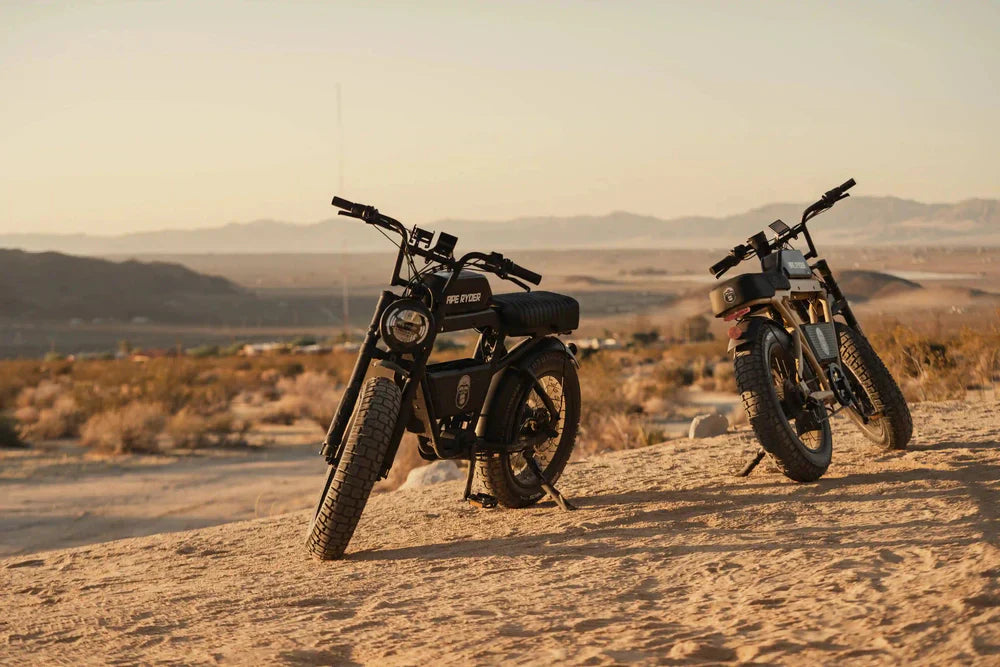The need for the realization of eco-friendly and efficient modes of transportation has been highly relevant with increased urbanization. Among the urban commuter, outdoor enthusiast, and eco-conscious individual, e-bikes and e-scooters are two of the most used choices. Which one will suit your needs best? This guide compares the differences, advantages, and disadvantages of the two to help make a correct choice.
What are E-Bikes and E-Scooters?
E-bikes have the configuration of traditional bicycles but are installed with an electric motor to assist in pedaling. Equipped with pedal-assist and throttle structures, e-motorcycles will offer a extra easy alternative for folks that battle up hills or with longer distances. An e-scooter is small, stand-on transportation run with the aid of an electric powered motor. These are meant for shorter transportation, permitting one to gracefully navigate city streets. Both have rechargeable batteries that could substantially lessen carbon emissions from different sorts of conventional transportation.
Environmental Benefits
These new transportation modes share one important role-that of e-mobility-and promote ways for humans to get away from fossil fuels. E-bikes commonly possess larger-sized batteries and tend to facilitate long-distance commuting without emissions, whereas e-scooters serve a more short-ranged function due to the smaller scale of their battery component but still promise ecological travel in both cases, therefore contributing greatly to better quality in urban atmospheric air.
Cost Considerations
E-bikes are generally greater expensive up-front, starting from numerous hundred to 3 thousand greenbacks for distinctive models and capabilities. However, they may be really worth making an investment in for the long time because of their durability and versatility. In comparison, e-scooters have decrease preliminary purchase costs that lead them to more on hand to buyers on a budget. Maintenance for e-scooters is also simpler and much less steeply-priced, although their shorter lifespan tends to offset these savings over time.
Speed and Range
E-bikes reach speeds of 20-28 miles per hour, the distance covered is 20 to 100 miles on a single charge. This depends at the type of batteries and the terrain. These traits lead them to ideal for longer commutes and diverse terrains. Most e-scooters have top speeds of 15-20 miles according to hour and will do 10-30 miles on a unmarried price, making them exquisite for small trips and errands around the block.
Portability and Storage
E-scooters are extremely easy to maneuver and manage when it comes to their portability. Their light-weight, foldable designs cause them to very clean to hold and shop in compact spaces. This is a godsend for the metropolis dweller who may also need to combine his ride with public shipping. E-bikes are bulkier but additionally may be realistic with functions like removable in-body batteries and folding frames, although taking on extra storage area.
Exercise and Health Benefits
For those who want to combine transportation with exercise, e-bikes are the clear winner. Riders can pedal for a workout and switch to electric assist when needed. That flexibility makes e-bikes a great choice for improving fitness during daily commutes. E-scooters, while convenient, don't provide the same level of physical activity; instead, they cater more to those seeking low-effort transportation.
Safety Features
Both ebikes and escooters pose a concern for safety, yet each is very different in design. Ebikes are much more stable, with larger frames and wheels, and boast advanced braking systems and lights for increased visibility. E-scooters, with their smaller wheels and higher center of gravity, can be more difficult to maneuver over rough terrain, although many do now come fitted with dual braking systems and LED lights for added safety.
Legal Regulations
Regulations for e-bikes and e-scooters vary by location. E-bikes are usually labeled primarily based on velocity and motor strength, often allowed on bike lanes and roads. E-scooters face stricter regulations in some areas, with barriers on velocity and designated driving zones. Understanding nearby legal guidelines is vital before you decide.
Community and Customization
While both options utilize group rides, events, and online forums for community building, e-bikes have significantly more possibilities regarding customization. The e-bike will enable one to attach cargo racks, baskets, upgraded tires, and any number of other accessories one can dream of to improve functionality and style. The e-scooters are rather limited in this respect, though minor modifications do exist, such as upgraded lights and grips.
Longevity and Sustainability
E-bikes are tougher, longer-lived, as they are strongly built and most of their parts are replaceable. If properly sorted, they are able to closing for numerous years. E-scooters are long lasting, although they're more liable to put on and tear from city environments. Technology keeps to cause them to extra durable, but their standard usability may be shortened through their small length and confined range.
Making the Right Choice
It all depends on your desires, preferences, and your style of life in determining whether to get an e-bike or an e-scooter. If your commutes are fairly lengthy, this one proves quite bendy for such rides and really adventurous to the day-to-day exercising one gets from taking walks some errands round metropolis. Where comfort, portability, and a much less high priced answer for shorter trips are desired, discover an e-scooter. None of those will harm the environment and make contributions to metropolis mobility. Consider area, your price range, garage, and health dreams.
Let's discover Ape Ryder's commuter and fat tire e-bikes.









Leave a comment
All comments are moderated before being published.
This site is protected by hCaptcha and the hCaptcha Privacy Policy and Terms of Service apply.